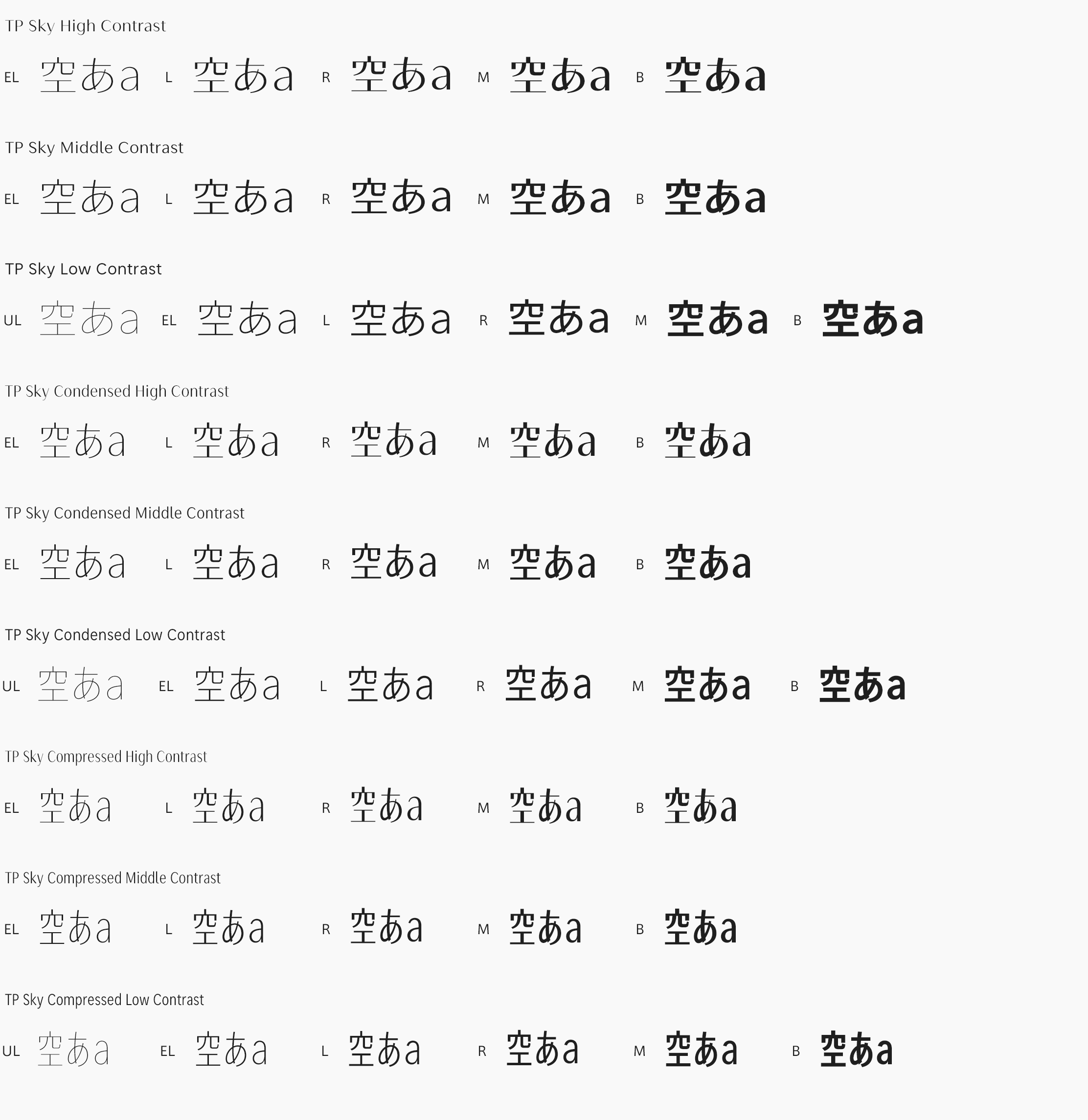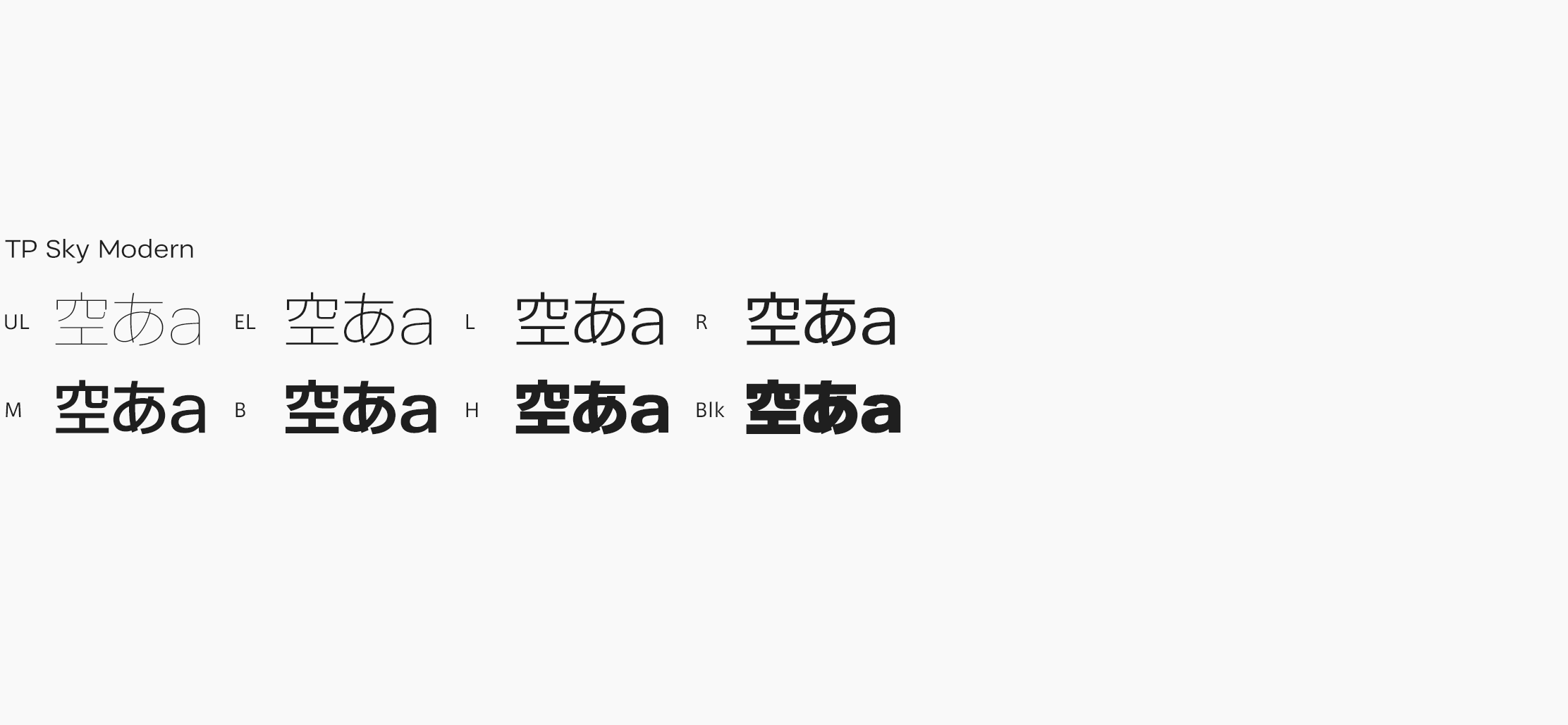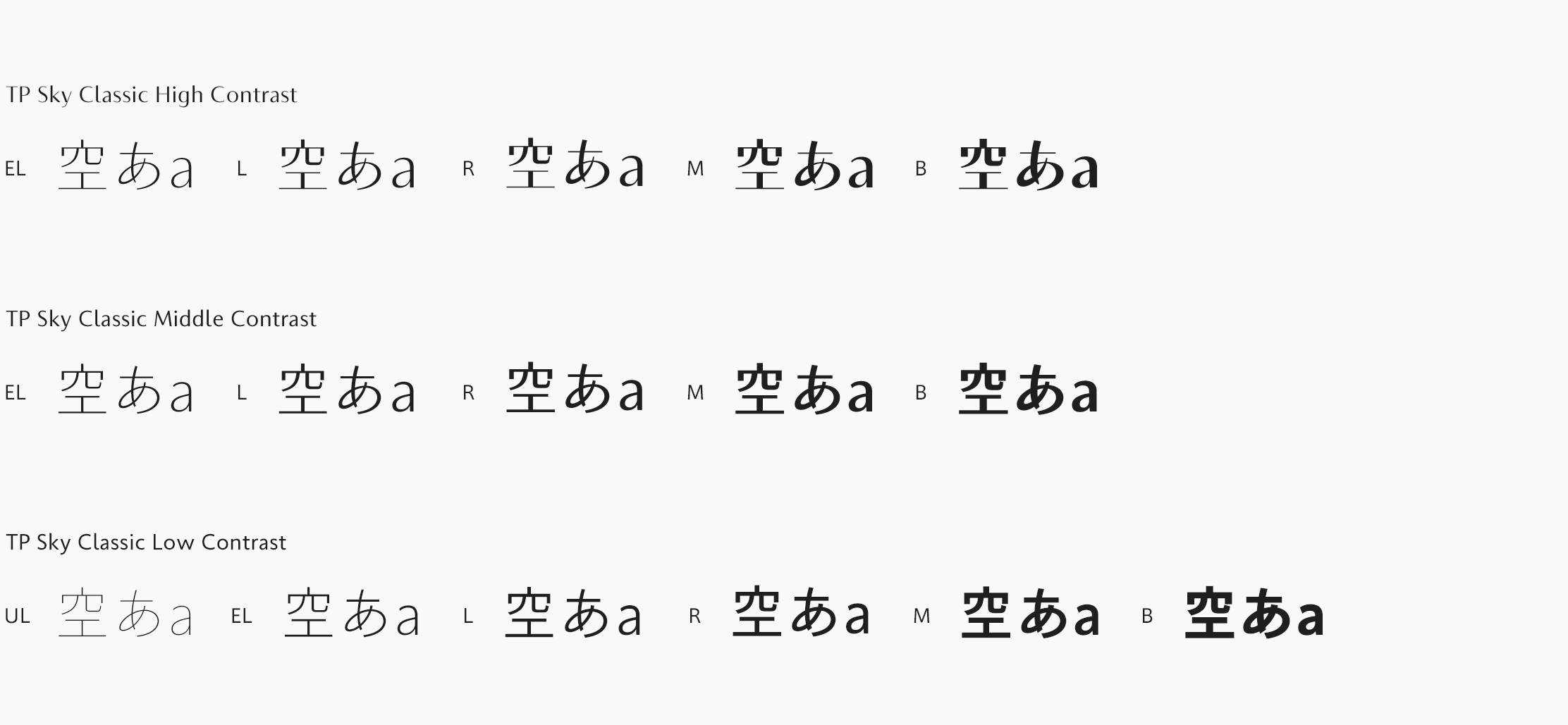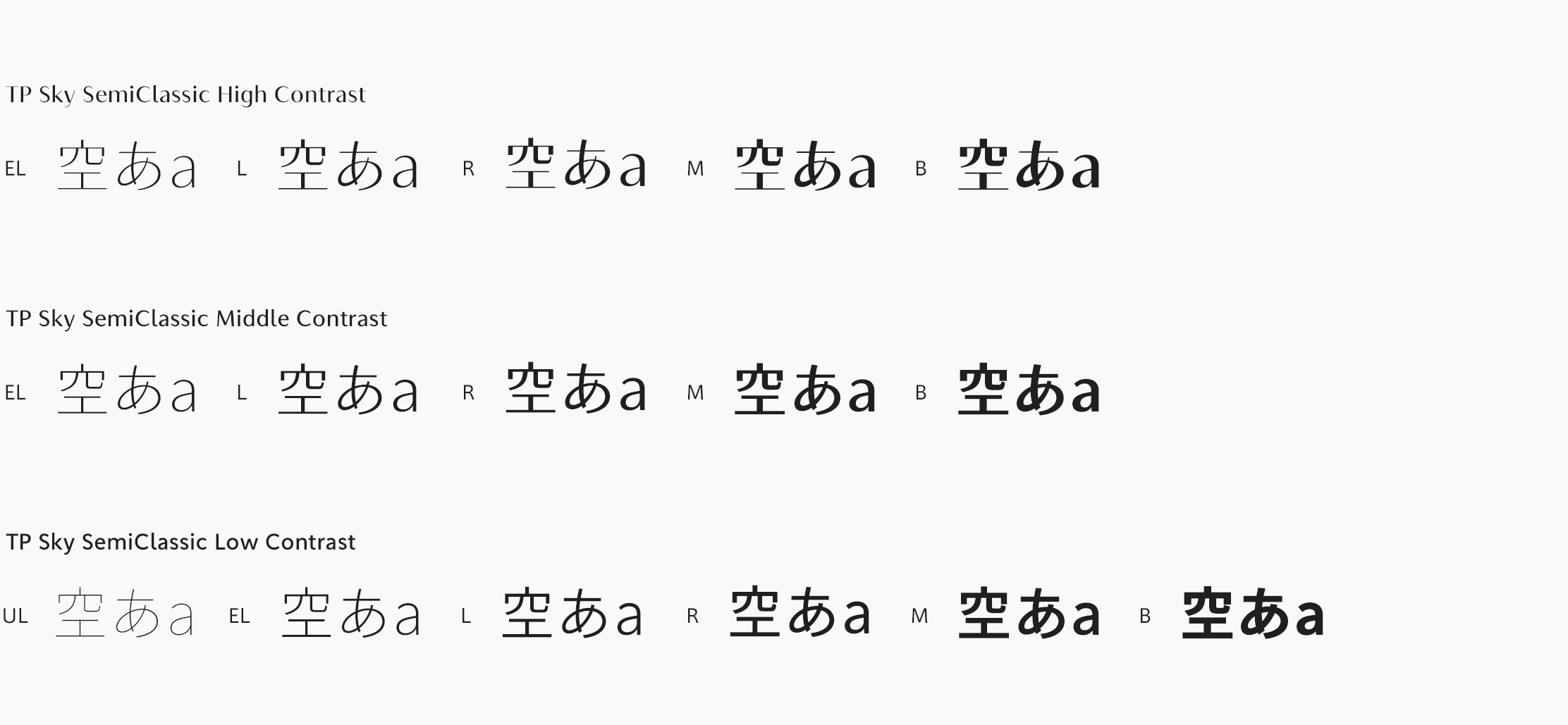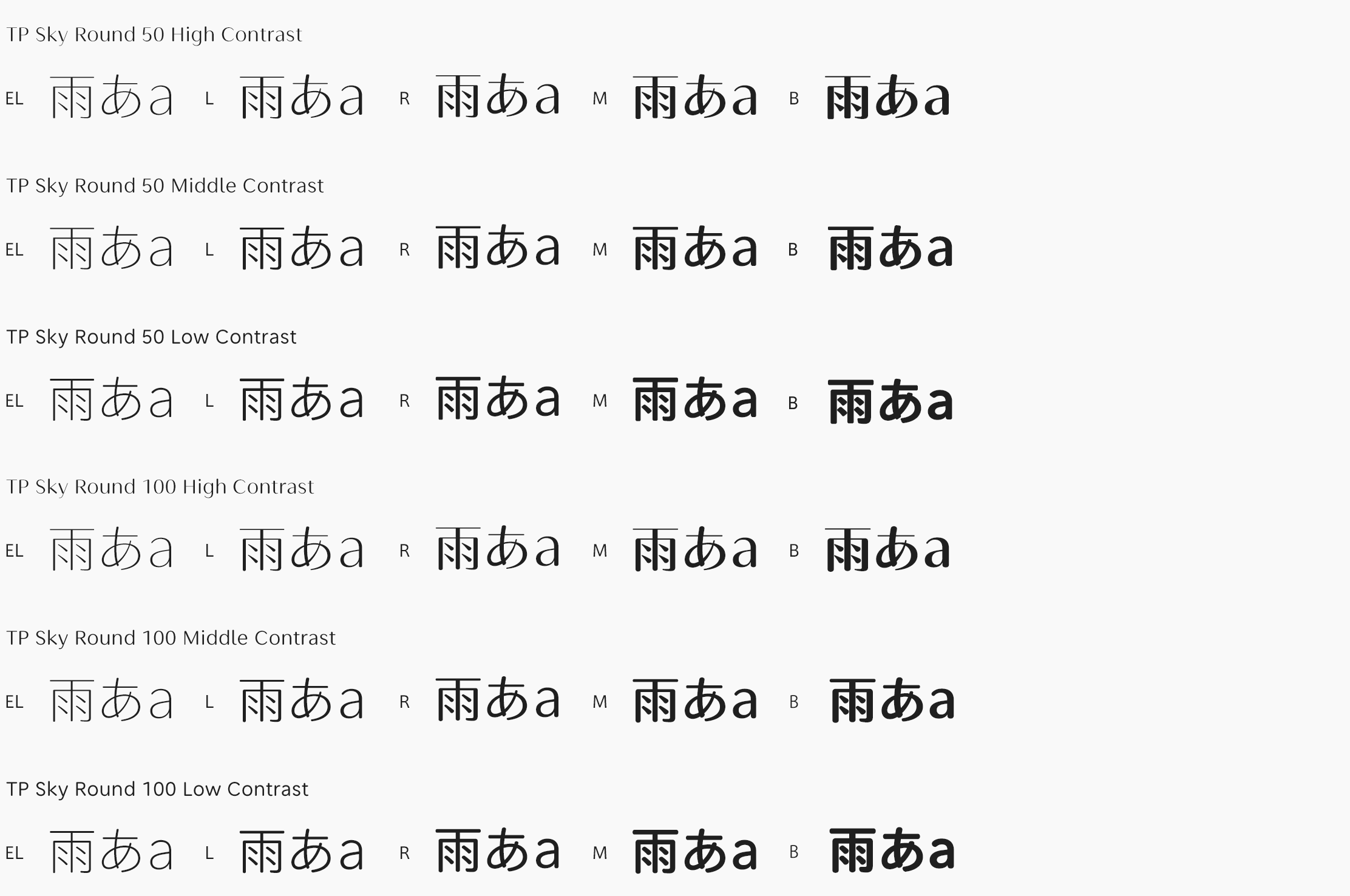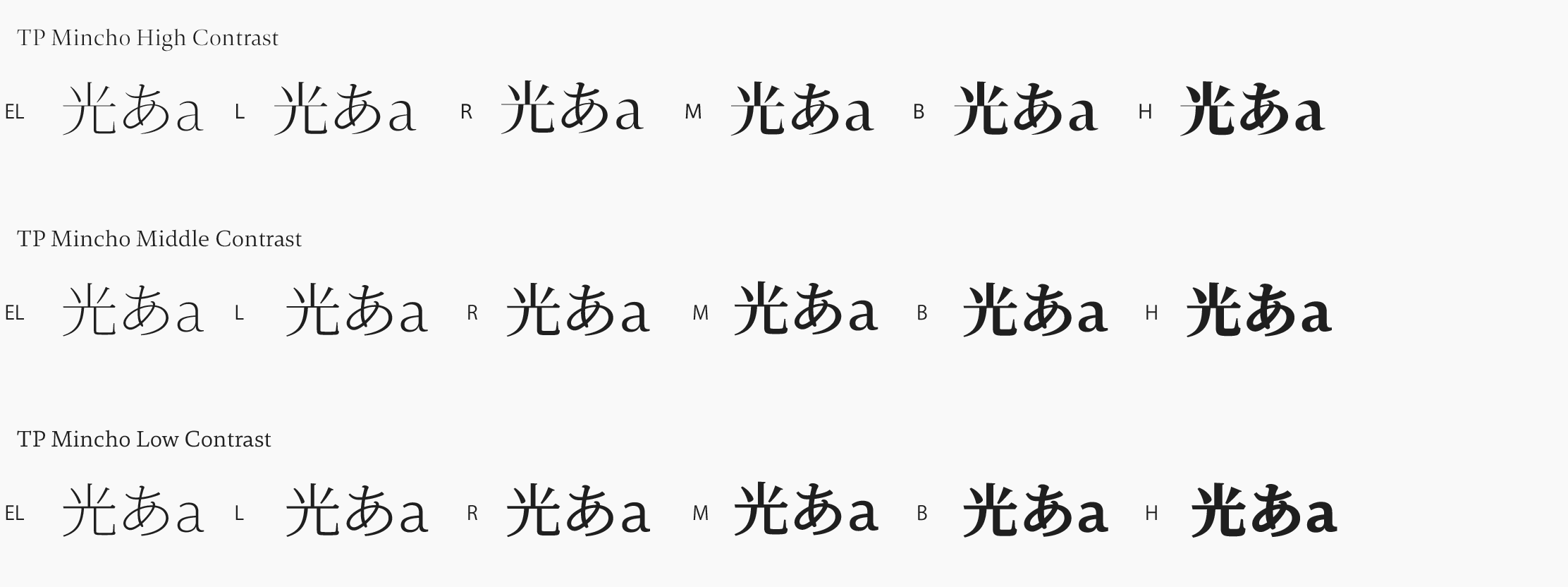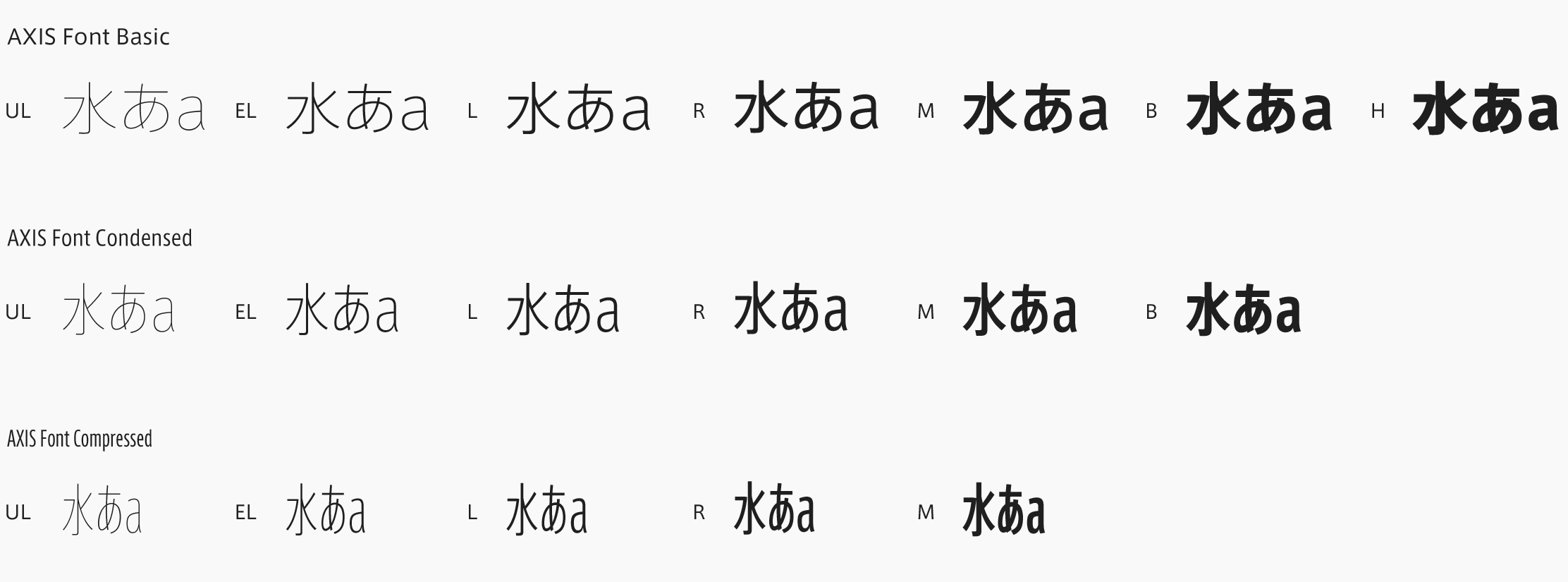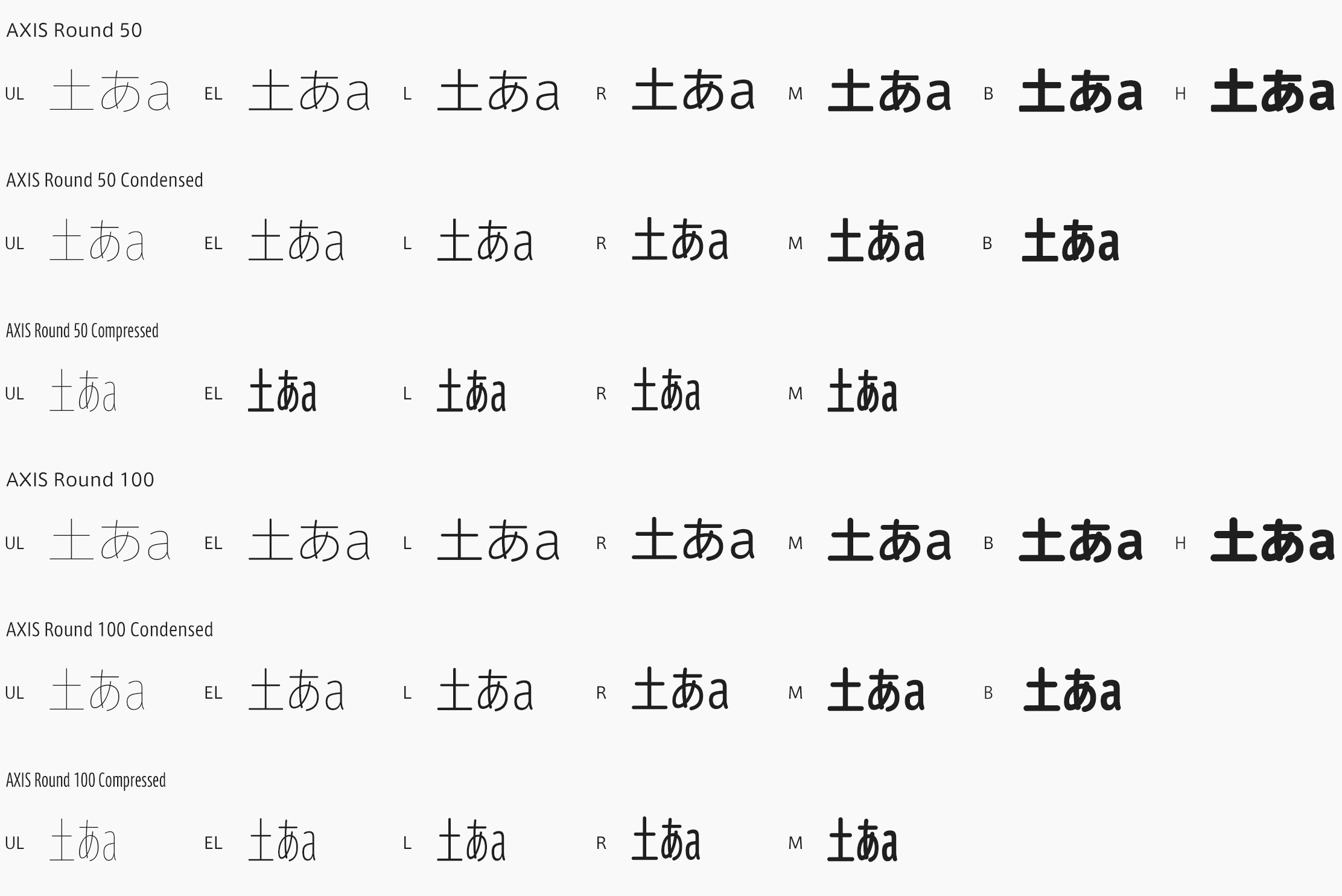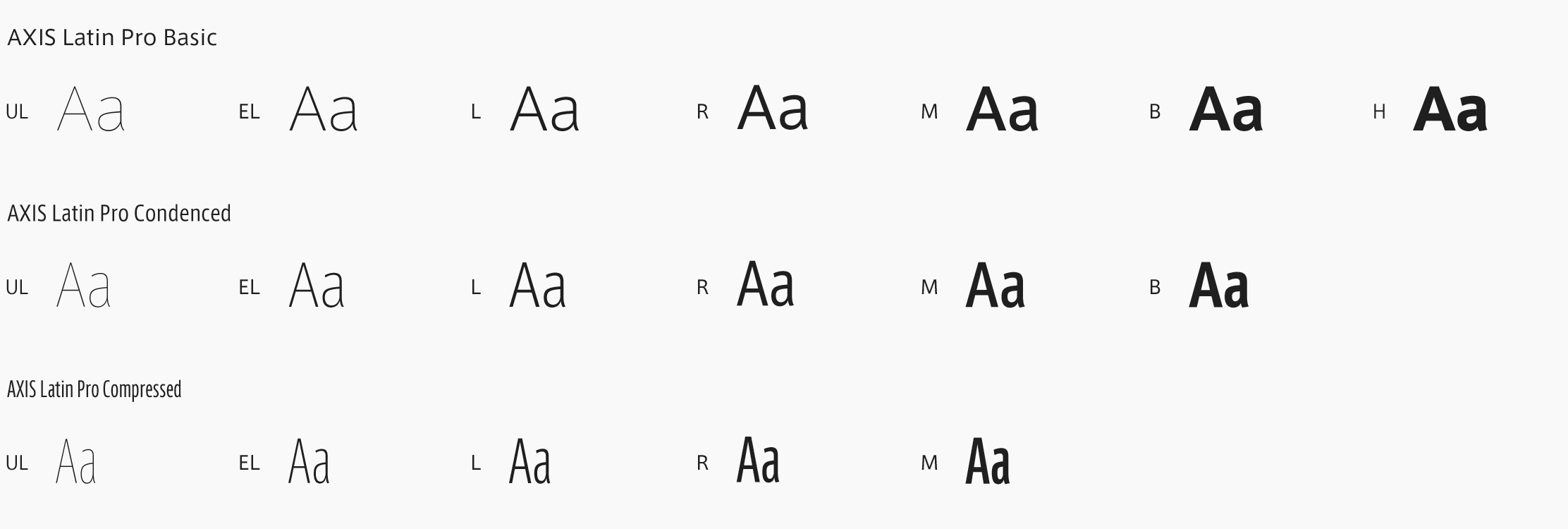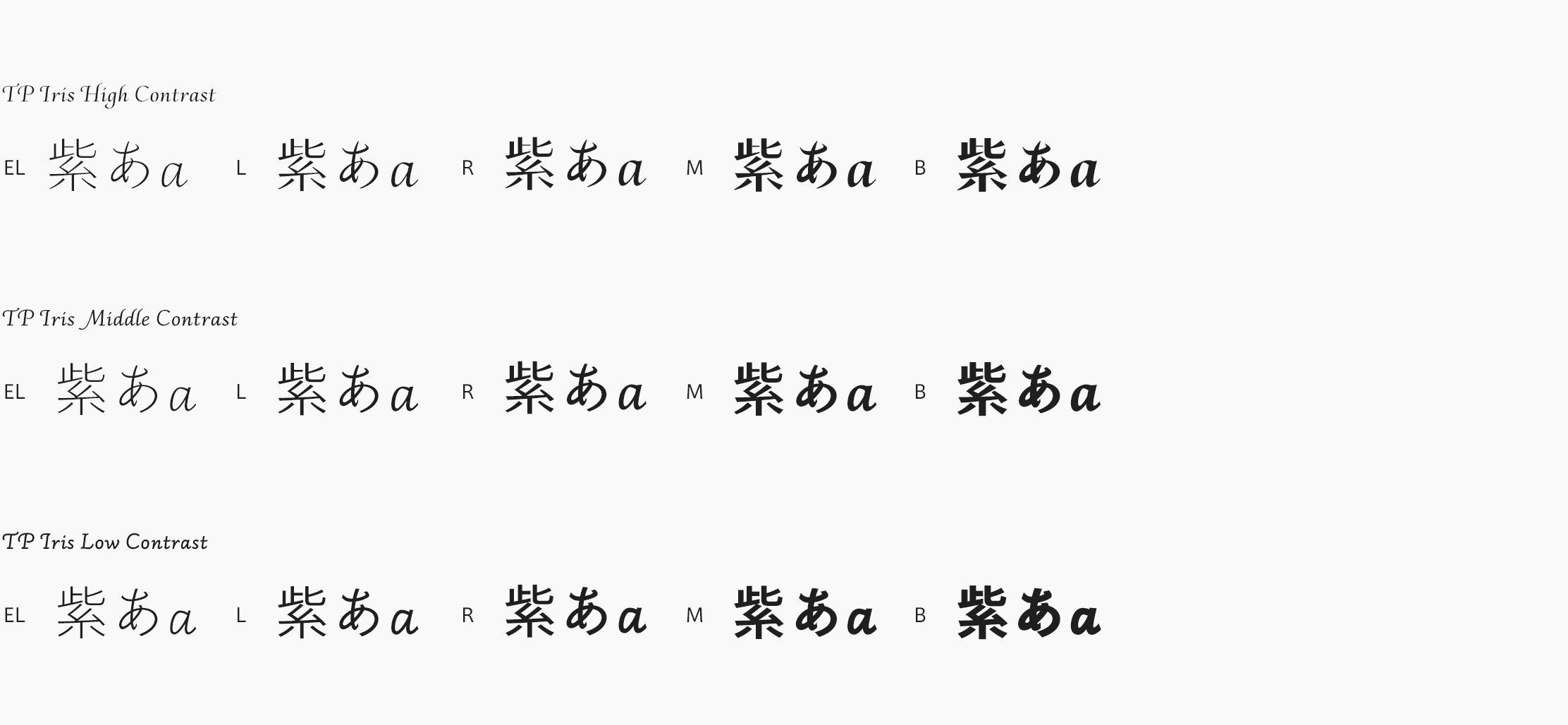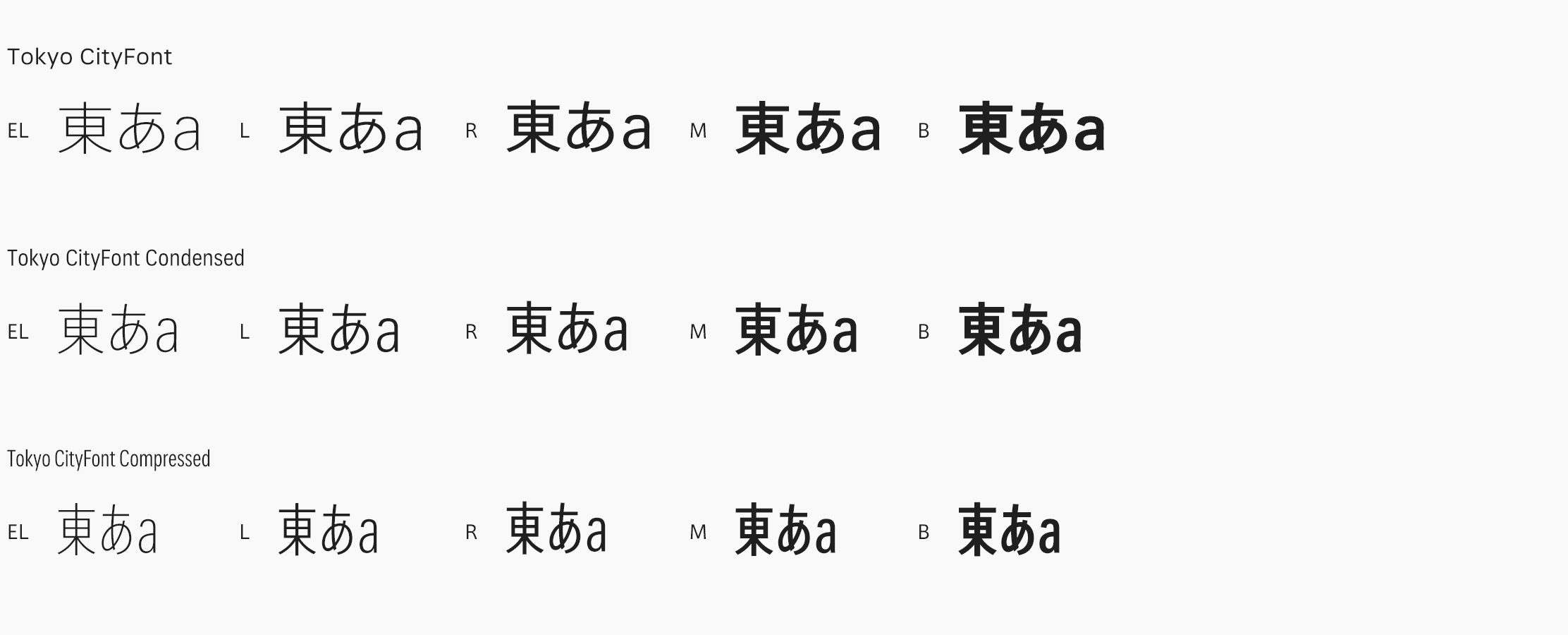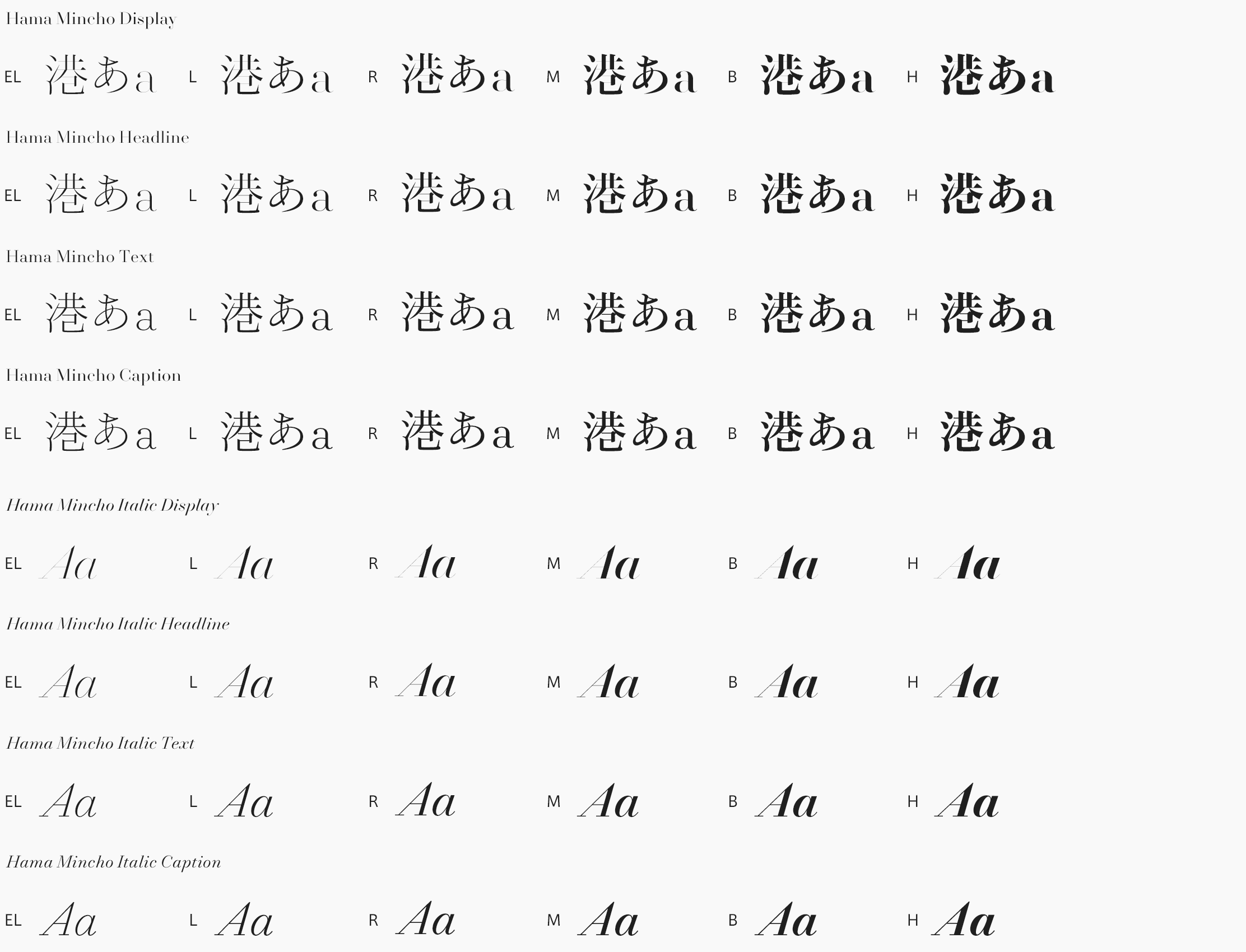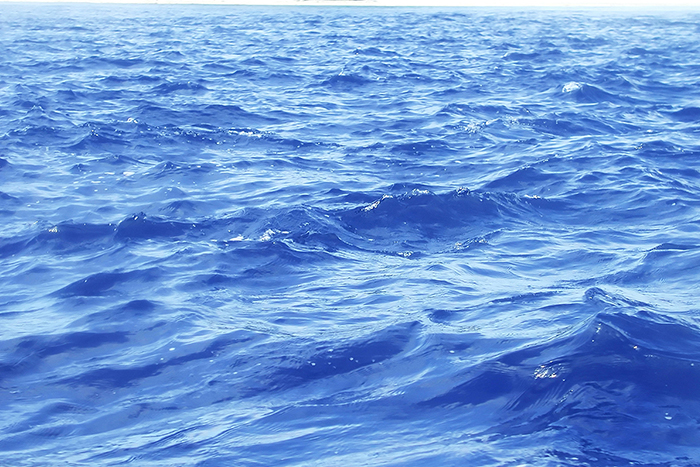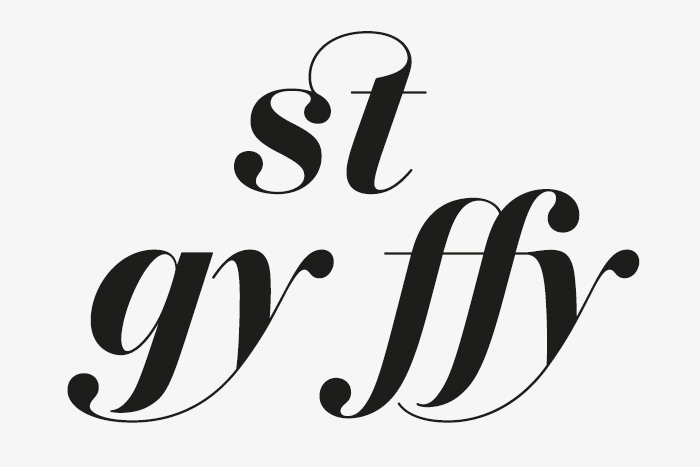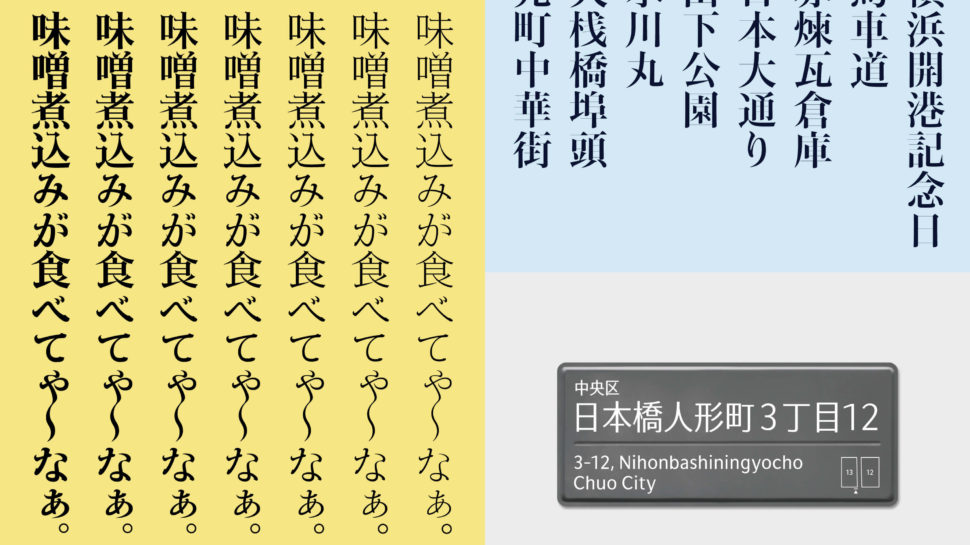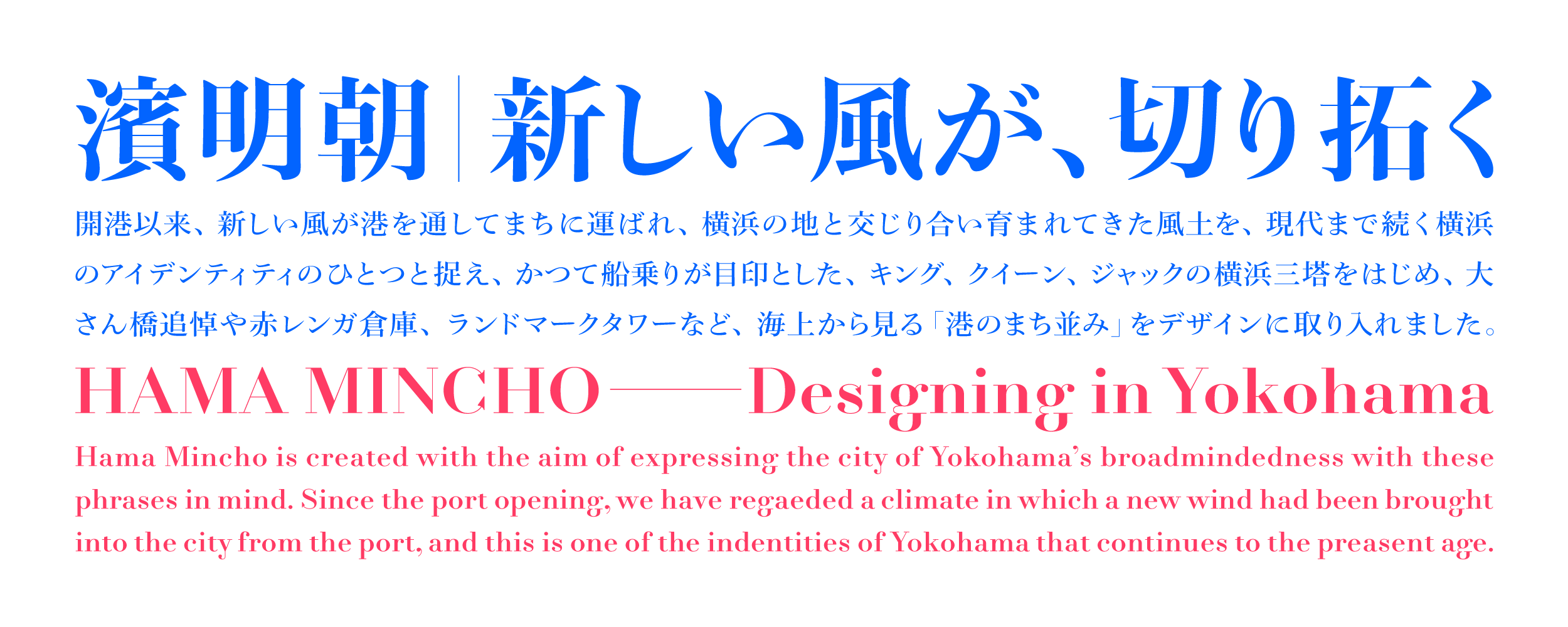
-
A Caption
-
A Text
-
A Headline
-
A Display
-
Buy
Hama MinchoCaption
EL
Yokohamaのまち並みから生まれた、濱明朝 4つの太さのバリエーションで横浜の懐の深さを表現した明朝体 横画はフェリーを、縦画は海上から望む建築群を、欧文は風にはためく旗を表現しました。
-
Buy
Hama MinchoCaption
L
Yokohamaのまち並みから生まれた、濱明朝 4つの太さのバリエーションで横浜の懐の深さを表現した明朝体 横画はフェリーを、縦画は海上から望む建築群を、欧文は風にはためく旗を表現しました。
-
Buy
Hama MinchoCaption
R
Yokohamaのまち並みから生まれた、濱明朝 4つの太さのバリエーションで横浜の懐の深さを表現した明朝体 横画はフェリーを、縦画は海上から望む建築群を、欧文は風にはためく旗を表現しました。
-
Buy
Hama MinchoCaption
M
Yokohamaのまち並みから生まれた、濱明朝 4つの太さのバリエーションで横浜の懐の深さを表現した明朝体 横画はフェリーを、縦画は海上から望む建築群を、欧文は風にはためく旗を表現しました。
-
Buy
Hama MinchoCaption
B
Yokohamaのまち並みから生まれた、濱明朝 4つの太さのバリエーションで横浜の懐の深さを表現した明朝体 横画はフェリーを、縦画は海上から望む建築群を、欧文は風にはためく旗を表現しました。
-
Buy
Hama MinchoCaption
H
Yokohamaのまち並みから生まれた、濱明朝 4つの太さのバリエーションで横浜の懐の深さを表現した明朝体 横画はフェリーを、縦画は海上から望む建築群を、欧文は風にはためく旗を表現しました。
-
Buy
Hama MinchoText
EL
Yokohamaのまち並みから生まれた、濱明朝 4つの太さのバリエーションで横浜の懐の深さを表現した明朝体 横画はフェリーを、縦画は海上から望む建築群を、欧文は風にはためく旗を表現しました。
-
Buy
Hama MinchoText
L
Yokohamaのまち並みから生まれた、濱明朝 4つの太さのバリエーションで横浜の懐の深さを表現した明朝体 横画はフェリーを、縦画は海上から望む建築群を、欧文は風にはためく旗を表現しました。
-
Buy
Hama MinchoText
R
Yokohamaのまち並みから生まれた、濱明朝 4つの太さのバリエーションで横浜の懐の深さを表現した明朝体 横画はフェリーを、縦画は海上から望む建築群を、欧文は風にはためく旗を表現しました。
-
Buy
Hama MinchoText
M
Yokohamaのまち並みから生まれた、濱明朝 4つの太さのバリエーションで横浜の懐の深さを表現した明朝体 横画はフェリーを、縦画は海上から望む建築群を、欧文は風にはためく旗を表現しました。
-
Buy
Hama MinchoText
B
Yokohamaのまち並みから生まれた、濱明朝 4つの太さのバリエーションで横浜の懐の深さを表現した明朝体 横画はフェリーを、縦画は海上から望む建築群を、欧文は風にはためく旗を表現しました。
-
Buy
Hama MinchoText
H
Yokohamaのまち並みから生まれた、濱明朝 4つの太さのバリエーションで横浜の懐の深さを表現した明朝体 横画はフェリーを、縦画は海上から望む建築群を、欧文は風にはためく旗を表現しました。
-
Buy
Hama MinchoHeadline
EL
Yokohamaのまち並みから生まれた、濱明朝 4つの太さのバリエーションで横浜の懐の深さを表現した明朝体 横画はフェリーを、縦画は海上から望む建築群を、欧文は風にはためく旗を表現しました。
-
Buy
Hama MinchoHeadline
L
Yokohamaのまち並みから生まれた、濱明朝 4つの太さのバリエーションで横浜の懐の深さを表現した明朝体 横画はフェリーを、縦画は海上から望む建築群を、欧文は風にはためく旗を表現しました。
-
Buy
Hama MinchoHeadline
R
Yokohamaのまち並みから生まれた、濱明朝 4つの太さのバリエーションで横浜の懐の深さを表現した明朝体 横画はフェリーを、縦画は海上から望む建築群を、欧文は風にはためく旗を表現しました。
-
Buy
Hama MinchoHeadline
M
Yokohamaのまち並みから生まれた、濱明朝 4つの太さのバリエーションで横浜の懐の深さを表現した明朝体 横画はフェリーを、縦画は海上から望む建築群を、欧文は風にはためく旗を表現しました。
-
Buy
Hama MinchoHeadline
B
Yokohamaのまち並みから生まれた、濱明朝 4つの太さのバリエーションで横浜の懐の深さを表現した明朝体 横画はフェリーを、縦画は海上から望む建築群を、欧文は風にはためく旗を表現しました。
-
Buy
Hama MinchoHeadline
H
Yokohamaのまち並みから生まれた、濱明朝 4つの太さのバリエーションで横浜の懐の深さを表現した明朝体 横画はフェリーを、縦画は海上から望む建築群を、欧文は風にはためく旗を表現しました。
-
Buy
Hama MinchoDisplay
EL
Yokohamaのまち並みから生まれた、濱明朝 4つの太さのバリエーションで横浜の懐の深さを表現した明朝体 横画はフェリーを、縦画は海上から望む建築群を、欧文は風にはためく旗を表現しました。
-
Buy
Hama MinchoDisplay
L
Yokohamaのまち並みから生まれた、濱明朝 4つの太さのバリエーションで横浜の懐の深さを表現した明朝体 横画はフェリーを、縦画は海上から望む建築群を、欧文は風にはためく旗を表現しました。
-
Buy
Hama MinchoDisplay
R
Yokohamaのまち並みから生まれた、濱明朝 4つの太さのバリエーションで横浜の懐の深さを表現した明朝体 横画はフェリーを、縦画は海上から望む建築群を、欧文は風にはためく旗を表現しました。
-
Buy
Hama MinchoDisplay
M
Yokohamaのまち並みから生まれた、濱明朝 4つの太さのバリエーションで横浜の懐の深さを表現した明朝体 横画はフェリーを、縦画は海上から望む建築群を、欧文は風にはためく旗を表現しました。
-
Buy
Hama MinchoDisplay
B
Yokohamaのまち並みから生まれた、濱明朝 4つの太さのバリエーションで横浜の懐の深さを表現した明朝体 横画はフェリーを、縦画は海上から望む建築群を、欧文は風にはためく旗を表現しました。
-
Buy
Hama MinchoDisplay
H
Yokohamaのまち並みから生まれた、濱明朝 4つの太さのバリエーションで横浜の懐の深さを表現した明朝体 横画はフェリーを、縦画は海上から望む建築群を、欧文は風にはためく旗を表現しました。
About Product
Overview
Hama Mincho’s (Hama refers to Yokohama and means ‘beach’) design incorporates the scale and distinctive character of the city of Yokohama, and for styles that accentuate vertical/horizontal stroke contrasts. On the basis of impressions of Yokohama that were gained through fieldwork, and more than 2000 phrases that were collected from local residents in a branding program held on the occasion of the 150th anniversary of the opening of the city’s port, the following key phrases were chosen: ‘A stylish town’, ‘A port alongside history’, and ‘Coexistence of tradition and new things’. The 24 font family of Hama Mincho is created with the aim of expressing the city of Yokohama’s broadmindedness with these phrases in mind.
Since the port opening, we have regarded a climate in which a new wind had been brought into the city from the port, and this is one of the identities of Yokohama that continues to the present age. We have adapted the image of “Port of Town” as seen from the sea, such as Osanbashi Pier, the Red Brick Warehouse, the Landmark Tower and three Yokohama towers which have been given the nicknames the King, the Queen and the Jack, used as landmark by former sailors.
Hama Mincho Italic is designed to recall the wind and waves of Yokohama with an overall flow line shape. Although the typical Latin italic typeface is assumed to be used along with the regular Latin typeface, Hama Mincho Italic is created with the aim of playing the role of a display typeface even by itself.
Harmonizing features by weight in the regular style, there are parts in which the shape and proportion of individual letters are intentionally changed from the regular style. In contrast with the design of regular that is close to a high contrast, simple kanji, the italic typeface is finished with the impression of kana, with the soft atmosphere of a remaining hidden ink brush connection.
Concept
This is a Mincho typeface that accentuates thickness variations and vertical/horizontal stroke contrasts, evokes in its horizontals the ferries that traverse the harbor, and in its verticals the city’s tall buildings seen from the ocean. The styles that accentuate vertical/horizontal stroke contrasts, Hama Mincho is created with the aim of expressing the city of Yokohama’s broadmindedness and openness to adopting new things. Thickness variations have been included while maintaining design consistency, so as to enable use for titles and headings, and to accommodate main text and footnote situations as well. For Latin that gives a sense of port likeness, such as images of flags flapping in the wind and an anchor, modern Roman typeface is adopted in consideration of harmony with kanji.
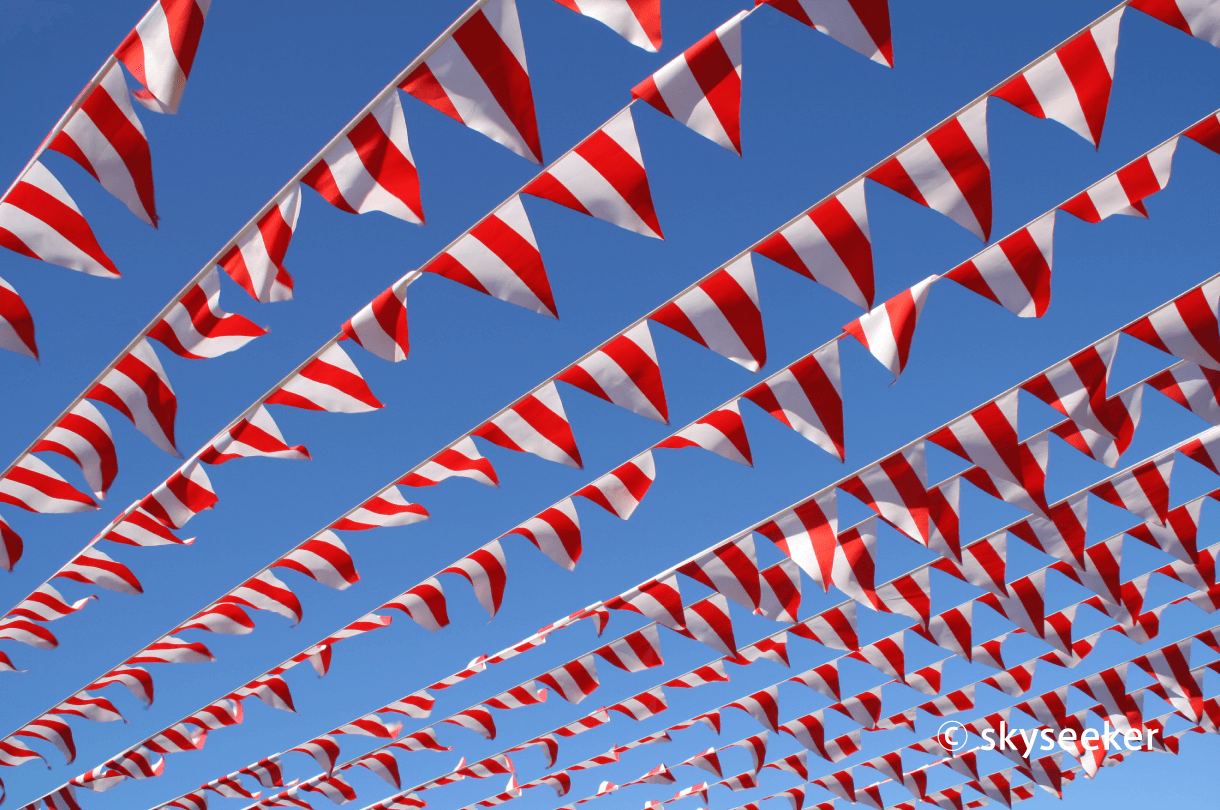
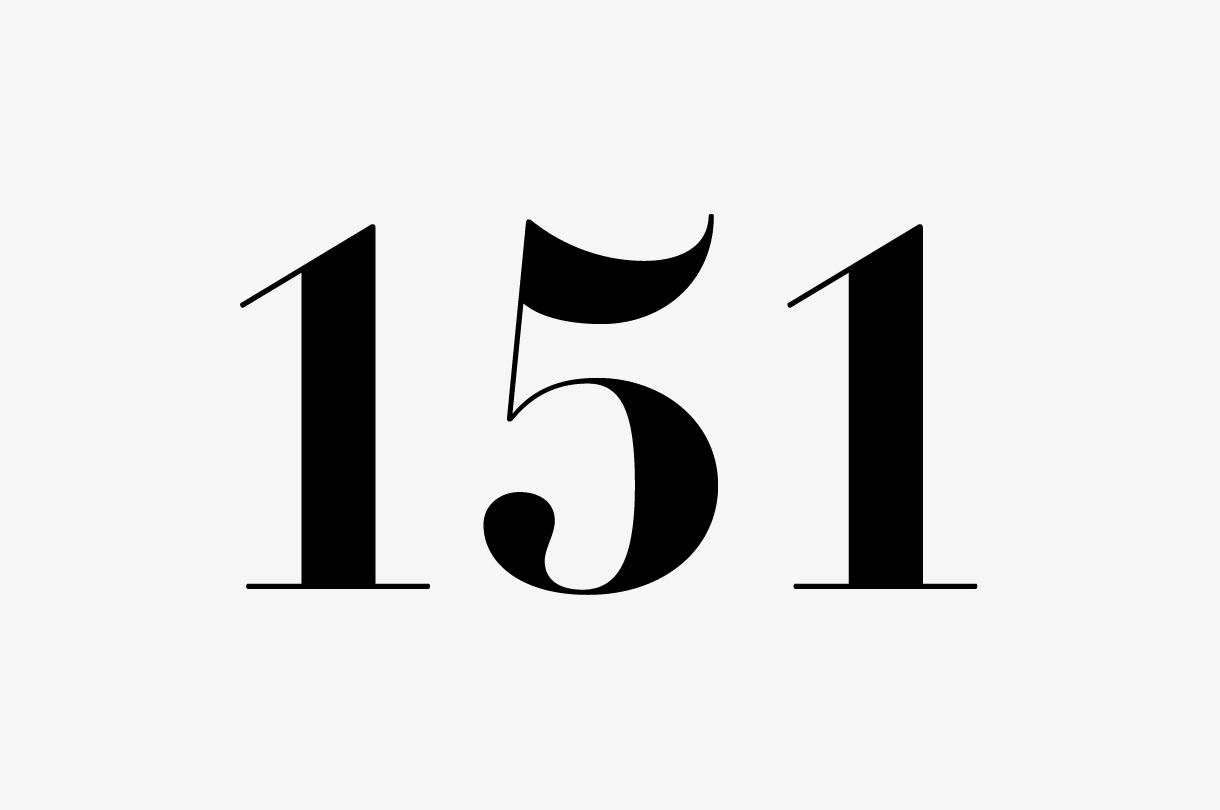
The letter structure of Hama Mincho Italic differs depending on the variation. In high contrast, thick fonts, such as Display H, etc., a soft and rounded modern Roman style design similar to regular is adopted to give a glamorous atmosphere that stands out in large sizes. In low contrast, thin fonts, such as Caption EL, etc., the narrowed classical italic structure is adopted to give an easy-to-read design for use in small sizes or longer sentences.

Features
The motif for the horizontal strokes is the ocean liner Hikawa Maru. The motif for the vertical strokes is the city’s tall buildings seen from the ocean.
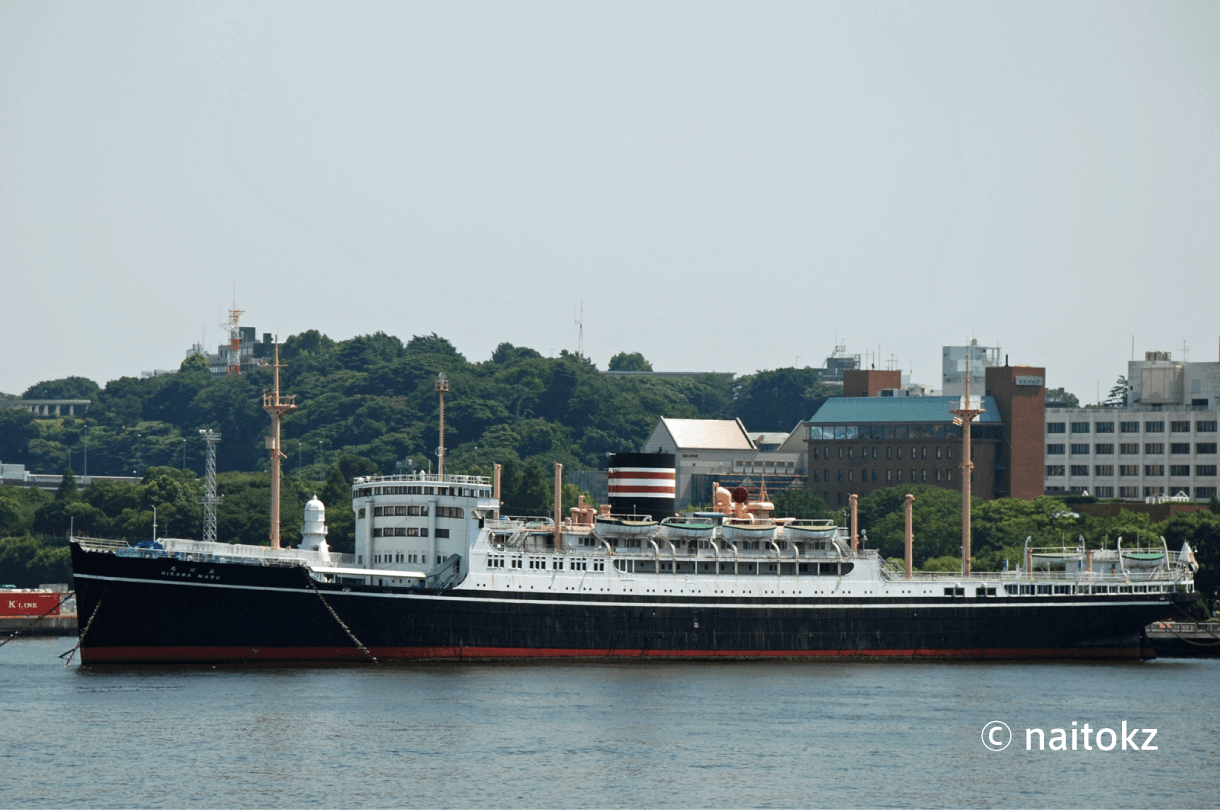
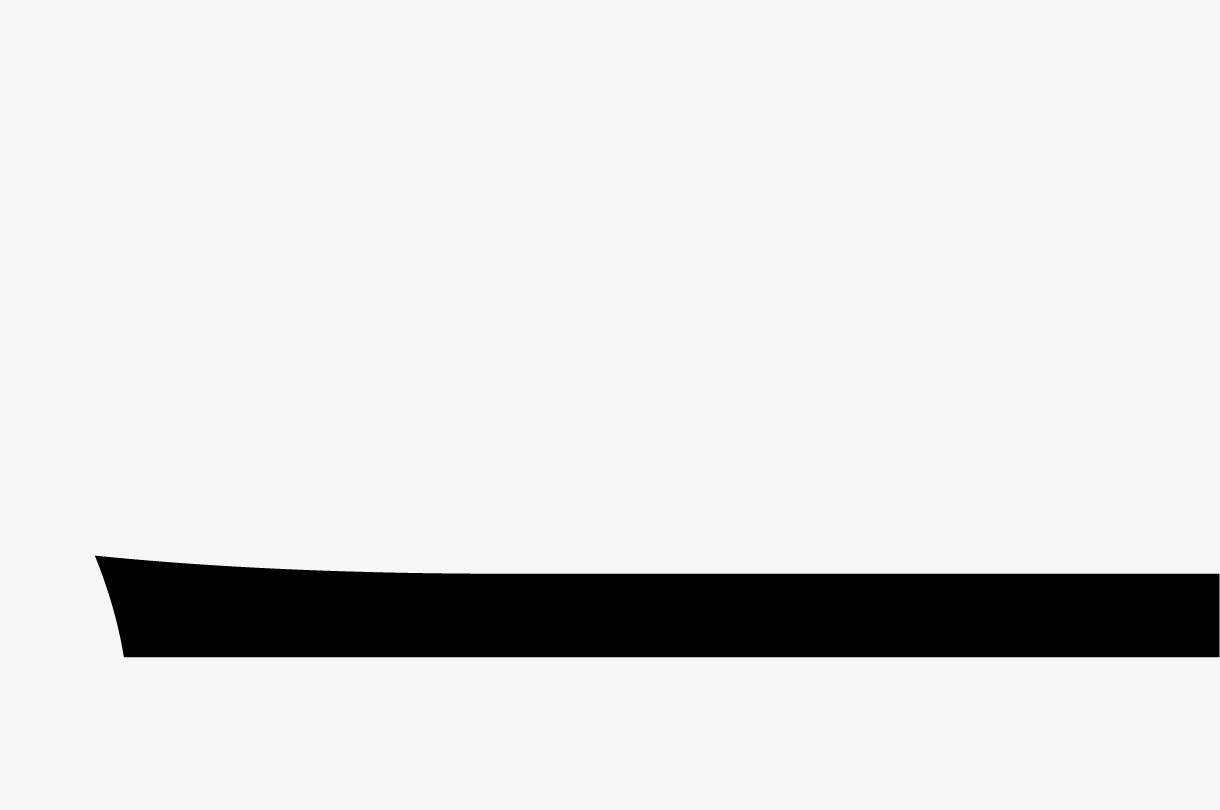
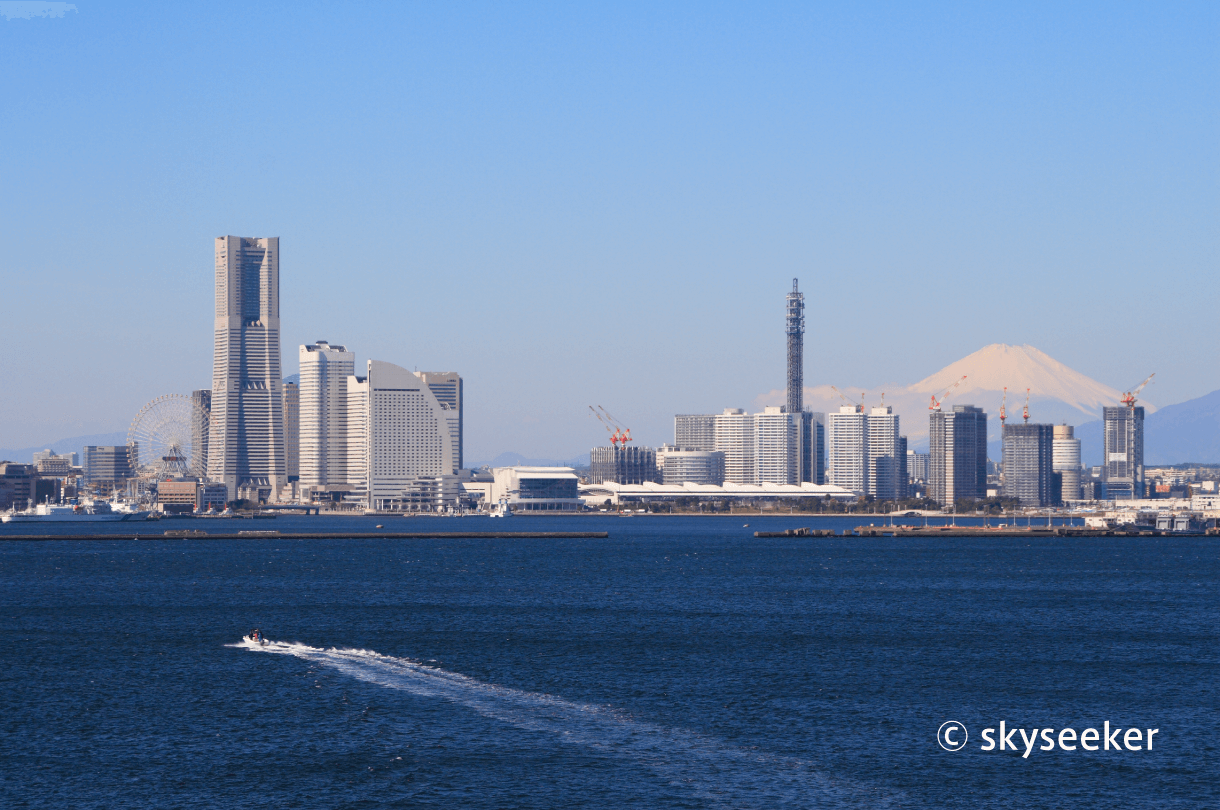
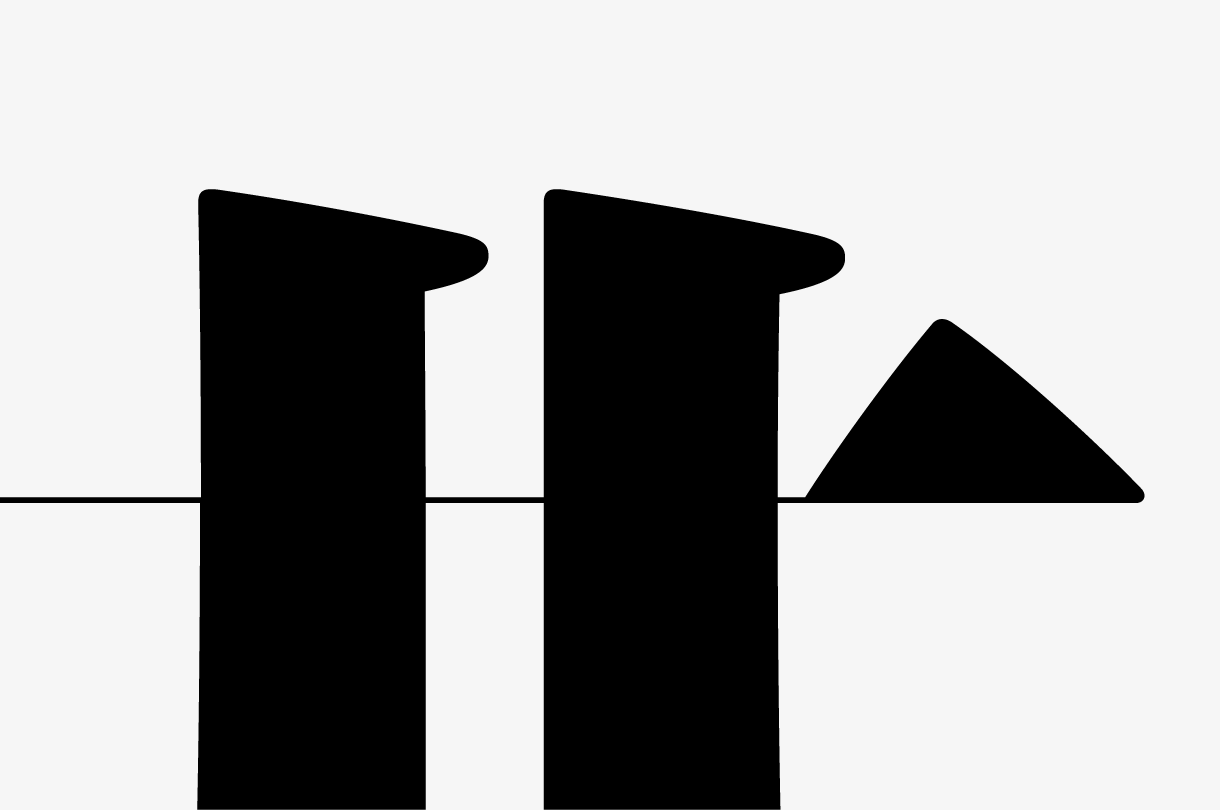
In addition to differences in design per variation, ligatures, proportional numerals, and old style numerals are added in Hama Mincho Italic. In ligatures with ornamental design, such as ‘st’, ‘fy’, etc., a bow shape line is adopted in the ascender (the upper part of a lowercase letter) and the descender (the lower part of a lowercase letter). This design, with the impression of a wave form, provides glamour to writing. In addition to monospaced lining numerals with the same height, proportional numerals that can further smoothen the flow when arranged are also included. In addition to the original application of blending numerals with lowercase letters in long sentences, old style numerals can provide movement in the text due to letters uneven in height in the case of arranging just a few letters, such as in a heading, etc.
Also, the letter form of lowercase letters ‘v’ and ‘w’ changes depending on the variation. In Display and Headline, that assume the use in large size, a V-shaped letter form that emphasizes individuality and provides a sense of speed is adopted. In Text and Caption, a U-shaped letter form is adopted to blend in with other letters and promote smooth reading experience even in a long sentence.

Family
Hama Mincho’s design incorporates the scale and distinctive character of the city of Yokohama, and for styles that accentuate vertical/horizontal stroke contrasts. Thickness variations have been included while maintaining design consistency, so as to enable use for titles and headings, and to accommodate main text and footnote situations as well. And for styles that accentuate vertical/horizontal stroke contrasts, the usage range extends even further. Hama Mincho is designed as a family series, with the four categories of Caption, Text, Headline and Display, each of which is available in six weights.
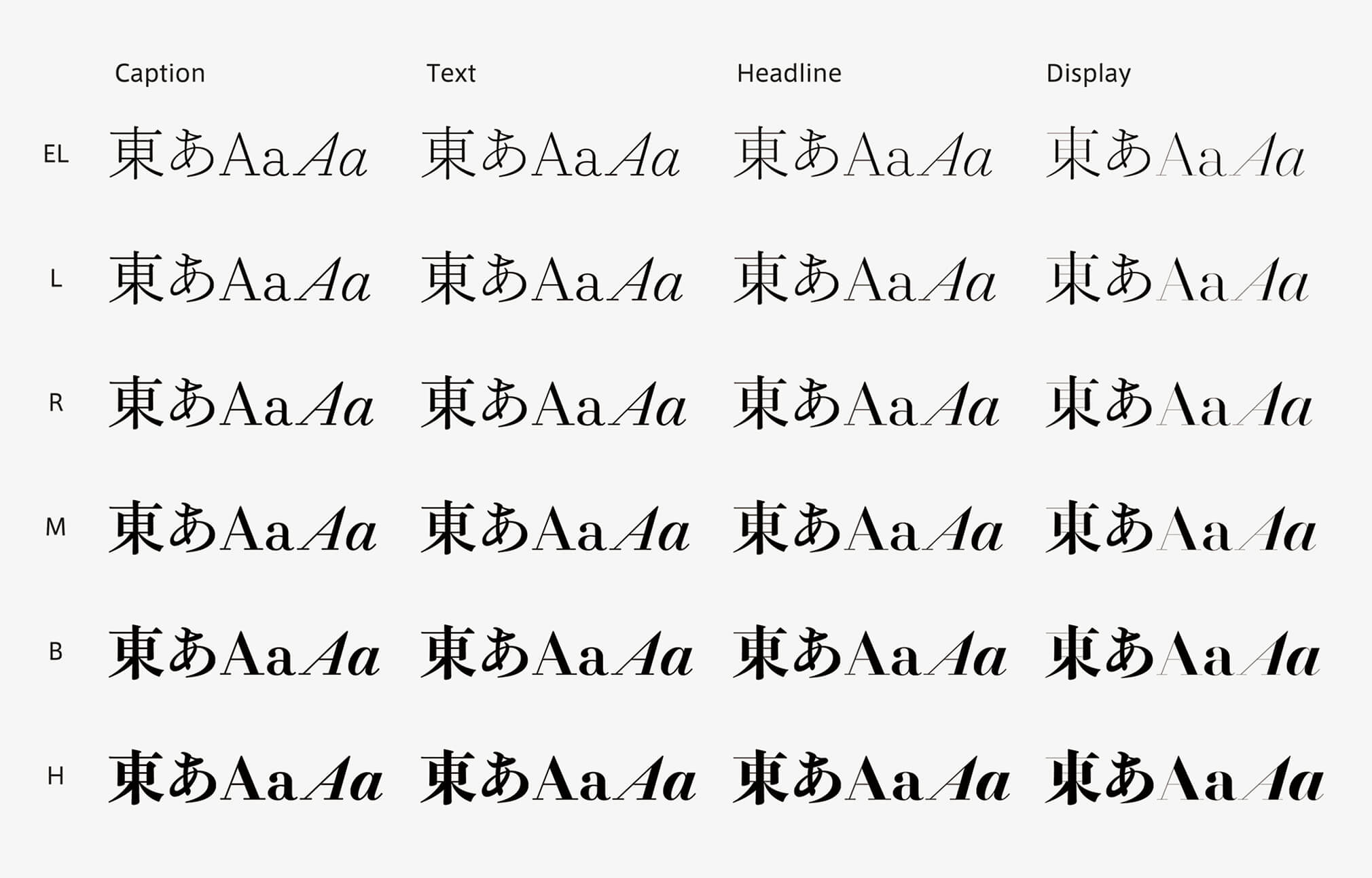
Specifications
| Main feature |
OpenType font Cross platform Extractable outlines PDF embedded Kerning information Dynamic download No resolution restrictions |
| Supported operating system |
macOS Windows 10/11 |
| Font set |
Standard(StdN) 9,498 characters (Adobe-Japan1-3) Hama Mincho Italic 301 characters |
| Languages | Japanese font (Std/StdN) almost fully covers 30 languages shown below. Japanese font based on Adobe Japan 1.3 covers all ISO-8859-1 proportional characters and Š, š, Ž, ž, Œ, œ, Ÿ. Then AXIS Font Japanese version can be used as multilingual font when you compose text using proportional characters. However, not all corresponding half-width characters are included, only Latin font is covered by half-width characters. Japanese (main script and covers JIS X 0208:1997) / English/ Icelandic (íslenska) / Irish (Gaelige) / Afrikaans (Afrikaans) / Albanian (Gjuha Shqipe) / Italian (Italiano) / Indonesian (Bahasa Indonesia) / Estonian (Eesti keel) / Occitan (lenga d’òc) / Dutch (Nederlands : U+0132 “IJ” and U+0133 “ij” shall be divided into I/i and J/j) / Oromo (Oromiffa) / Galician (Galego) / Swedish (Svenska) / Scottish Gaelic (Gàidhlig) / Spanish (Español) / Swahili (Kiswahili) / Danish (Dansk) / German (Deutsch) / Norwegian (Bokmål) / Norwegian (Nynorsk) / Finnish (Suomi) / Faroese (Føroyskt) / French (Française) / Brasilian Portuguese (Português Brasileiro) / Breton (Brezhoneg) / Portuguese (Português) / Latin (Latina : Classical orthography, without vowels with macron) / Luxembourg (Lëtzebuergesch) / Rhaeto-Romance languages (Rhaetian) / Walon (Walloon) *Full width version of Greek uppercase/lowercase (24 characters for each, excluding ending form of sigma) and Cyrillic (Russian) uppercase/lowercase (33 characters for each) are included as JIS Row6 and Row 7 (These characters are defined as full width in JIS spec) Hama Mincho Italic almost fully covers 29 languages shown below. English/ Icelandic (íslenska) / Irish (Gaelige) / Afrikaans (Afrikaans) / Albanian (Gjuha Shqipe) / Italian (Italiano) / Indonesian (Bahasa Indonesia) / Estonian (Eesti keel) / Occitan (lenga d’òc) / Dutch (Nederlands : U+0132 “IJ” and U+0133 “ij” shall be divided into I/i and J/j) / Oromo (Oromiffa) / Galician (Galego) / Swedish (Svenska) / Scottish Gaelic (Gàidhlig) / Spanish (Español) / Swahili (Kiswahili) / Danish (Dansk) / German (Deutsch) / Norwegian (Bokmål) / Norwegian (Nynorsk) / Finnish (Suomi) / Faroese (Føroyskt) / French (Française) / Brasilian Portuguese (Português Brasileiro) / Breton (Brezhoneg) / Portuguese (Português) / Latin (Latina : Classical orthography, without vowels with macron) / Luxembourg (Lëtzebuergesch) / Rhaeto-Romance languages (Rhaetian) / Walon (Walloon) |
Related Posts
-
2020.07/01
Contribution to strengthening city identity
City Font Project

